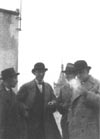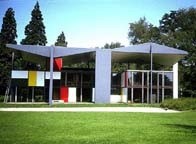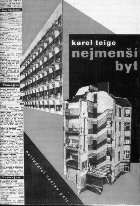 |
Vol 2, No 7 21 February 2000 |
|
|
 A R C H I T E C T U R E
A R C H I T E C T U R E An Independent Modernist Karel Teige's "Minimal Dwelling" against contemporary Socialist architecture Juan Gomez-Gutierrez After World War I, the experimental impulses of the first two decades of the century gave place to a period of social compromise in the European arts. In France, cubism evolved through styles like that of Picasso and the purists. These aimed to recompose the fragmented object in shapes inspired by knowledge and social action. In Russia, the avant-garde artists became engineers at the service of the socialist state, while in Italy the different trends of modernism competed against each other to become the official art of the fascist state. The appearance of Socialist Realism in the mid 1920s was to exacerbate this post-war ├®lan - in many cases the political questions becoming not just a concern of the artists' but rather the very foundation of art. Karel Teige is an example of a theoretician whose aesthetic position was indistinguishable from his revolutionary political beliefs. He considered the historic distinction between traditional and modern art as being inextricably linked to the distinction between capitalism and Communism. However, he opposed Stalinist art strongly, not for subordinating art to politics but for betraying socialist principles by using architectural monumentality as an instrument of power to intimidate and repress the people. As an active member of the inter-war year's European artistic milieu, Teige seems to have responded to socialist realism with the arguments of the avant-garde and to the avant-garde with the arguments of Socialist Realism. Against the Grain His political beliefs led him to an independent and critical position vis-├Ī-vis the Congr├®s Internationaux d'├ürchitecture Moderne (CIAM) and the Russian constructivist architecture throughout the 1920s. Teige shared the functionalist assumption that the building had to be a response to human needs. He recognised the achievements of Walter Gropius, Mies van der Rohe and other CIAM members who sought to introduce improvements like central heating or bathrooms in working class dwellings. He also agreed that the benefits of technical progress could be assured for all social strata by means of industrial techniques based in mass production, prefabrication and the industrialisation of the construction process. However, he argued that Gropius and van der Rohe's conception of pure functional design departed from an a-historical understanding of human needs that led them to propose an "objective" model of dwelling which, for him, in fact meant nothing but a cheap version of the family-based bourgeois house. "Minimum Dwelling" Instead, Teige conceived architectural function as a variable category linked to a social content in permanent change and proposed what he called "Minimum Dwelling", an experimental model of socialist dwelling thought to be developed in the Soviet Union at massive scale. The theory of the Minimum Dwelling departed from the assumption that industrialisation and the political rise of the working class had introduced major changes in domestic life and that, therefore, architectural design had new functions to fulfil. The family had lost its role as an economic unit and, consequently, the woman had become emancipated and taken up employment outside the household. Accordingly, the traditional family house had to be redesigned, being divided into separate areas for each independent dweller and eliminating the marital bed, while collective laundries, canteens and kindergartens would take over the housewife's duties. Teige vs Le Corbusier
He foresaw that Le Corbusier's plans, when applied to low-income dwelling, would result in over-built states with an excessive density of population and a series of practical problems such as poor ventilation or lack of sunlight, derived from the superimposition of the classicist schema. On the other hand, Teige could see that Le Corbusier's elegant designs would become fashionable in the luxury market when enlarged. At the opposite end of the spectrum of ideas, Teige believed that the emphasis of the Russian constructivists on the tectonic qualities and the assemblage of materials was something arbitrary and reductionist as it did not take into account needs other than physical ones. It therefore failed to enrich its findings with the science of human psychology in order to provide a broader architectural theory, something that Socialist Realism had done - though in a perverse way.
However, because of the lack of political counterparts and patrons these were short-lived initiatives. In the East, Stalin's trials were taking place and Teige's Trotskyism, as well as his deeply polemic attitude, prevented him from exercising any influence on Soviet architecture. In the West, the CIAM majority rejected the pressure to line up with any political doctrine and began to appear as an organisation for technical purposes. In Czechoslovakia, Teige was still an undisputed guru of modernism, but, due to his dogmatic attitude and the pressures of the CIAM, younger architects were seeking to break away from the country's isolation. All these events combined to bring about the failure of Teige's architectural revolution and eventually moved him to seek refuge in more evasive and less socially engaged activities such as surrealist photomontage. Juan Gomez-Gutierrez, 21 February 2000
|
|
![]()
Copyright © 2000 - Central Europe Review and Internet servis, a.s.
All Rights
Reserved
 It is precisely this understanding of functionalism that led Teige to oppose Le Corbusier and the Russian constructivists also. He accused the Swiss architect of imposing on his buildings an a-priori harmony of shapes that was not aimed at fulfilling functional requirements, but rather at the pursuit of an a-historical classicism for its own sake.
It is precisely this understanding of functionalism that led Teige to oppose Le Corbusier and the Russian constructivists also. He accused the Swiss architect of imposing on his buildings an a-priori harmony of shapes that was not aimed at fulfilling functional requirements, but rather at the pursuit of an a-historical classicism for its own sake.  Leaving aside the somewhat utopian character of his Minimum Dwelling, Teige's critical attitude vis-├Ī-vis both the CIAM and the 1930s Soviet housing schemes left him isolated during the early 1930s. He participated in several attempts to organise an independent network of architects, both at national and international levels, such as L├®va Fronta (LEF) and the Europe-wide Association of Socialist Architects.
Leaving aside the somewhat utopian character of his Minimum Dwelling, Teige's critical attitude vis-├Ī-vis both the CIAM and the 1930s Soviet housing schemes left him isolated during the early 1930s. He participated in several attempts to organise an independent network of architects, both at national and international levels, such as L├®va Fronta (LEF) and the Europe-wide Association of Socialist Architects.